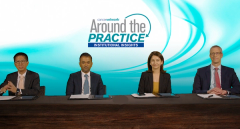
Treating Transplant-Ineligible NDMM With High-Risk Cytogenetics
Shared insight on the selection of therapy for patients with transplant-ineligible, newly diagnosed multiple myeloma and high-risk cytogenetics.
Episodes in this series

Transcript:
Noopur Raje, MD: One other issue which comes up, and I don't think your patient had the 1114 translocation, Omar, so we consider that standard risk. It's important to recognize that we have another option for that patient population with the use of venetoclax, but leaving that aside, do high-risk cytogenetics in the transplant-ineligible patients make a difference in your choice of medications? I'm going to first ask you and then Andrew to comment. Are high-risk cytogenetics in older patients the same as high-risk cytogenetics in younger patients?
Omar Nadeem, MD: That's another great question.
Noopur Raje, MD: I get to ask the question so it's easy, Omar.
Omar Nadeem, MD: When you see a high-risk patient and you know that you're not able to get through what we would want them to get through, which would be a quadruple induction transplant and perhaps multiagent maintenance. That's what we think about when we have a high-risk younger patient in front of us. I try to mirror that as much as I can with substantial dose modifications if there's a patient because the transplant-ineligible bucket is quite large. We have a patient who is in their early 70s with comorbidities, but reasonable performance status vs somebody who's 85 and frail; those are very different patient populations. In the first cohort, if that patient has high-risk disease, I will still try to get the best response as quick and as early as I can. In that case, dara [daratumumab] plus an RVD-lite [lenalidomide, bortezomib, dexamethasone] quadruplet is something that I would prefer, particularly in the high-risk patient to try to get that deep response, to get to MRD [minimal residual disease] negativity, and give them the best chance of having a longer-term first remission. That's the goal of that patient. If I have an older, frail patient, I usually don't think that's an option. At that time, you must tailor therapy based on the patient's performance status and overall condition, as opposed to the disease characteristics, and then try to get them on at least a triplet that you could then continue until progression.
Noopur Raje, MD: Andrew, any difference in thought?
Andrew J. Yee, MD: No, I agree. The question of high risk comes up, not infrequently, in terms of what he role of daratumumab is in high-risk, which I think was the question you're trying to nudge at. Some of the initial data with daratumumab in high risk, for example, in the MAIA study [NCT02252172], did not perform across the one. That was the initial look at it, but with more longitudinal follow-up, you can see that the hazard ratio improved in that specific high-risk patient population. When they did an analysis…. and the MAIA data for high-risk disease, the daratumumab added to those patient populations. At the end of the day, I don't think you have to choose between RVD-lite vs dara-RD. I know people want to force that choice, but for some patients where you have high risk and they're older, I use the dara-RVD-lite regimen. You want to extend what we've learned from RVD-lite in terms of the dose reductions and the lenalidomide starting off in the weekly bortezomib and combine that with daratumumab for older frailer patients; I think that can work well. Then adjust over time depending on response and tending on how the patient does with the treatment.
Noopur Raje, MD: The argument about dara not working in high risk, I think you looked at that question Jacob, in your GRIFFIN trial [NCT02874742]. And you showed us when you presented the data when you included, that part of the problem with some of the older trials is when you define high risk by just the translocations, the numbers of patients is always small and hard to see that benefit. You have to wait long enough to see those hazard ratios improve. That's where you added on the chromosome 1Q abnormalities. You saw that addition of daratumumab benefit the high-risk patient population, is that right, Jacob?
Jacob Laubach, MD, MPP: Yes.
Noopur Raje, MD: Based on the GRIFFIN trial. The last thing I will add is genetic risk is one thing, but the genetic risk in an 80-year-old with those same translocations is a bit different than what you see in a 45-year-old or a 50-year-old. Although it would be the same genetics, they don't have that same high-risk genetic outcome in that patient population. Having said that, I think all of us agree that we want to use the best possible treatments upfront, we want to try and get to the deepest possible responses upfront,and we want to try and maintain that response for as long as patients can tolerate it. It’s sometimes harder in the elderly patient population, and I will be the first one to that, admit although I love using four drug combinations. I have plenty of patients and Andrew can testify to that, where I use single agent drugs as well. You have an 85-year-old who cannot tolerate anything but will be on single agent daratumumab for example and it’s just as efficacious. It’s important for all of us to recognize and appreciate the heterogeneity within outpatient population and tailor treatment to a patient specifically.
Transcript edited for clarity.
Newsletter
Stay up to date on recent advances in the multidisciplinary approach to cancer.
































































































